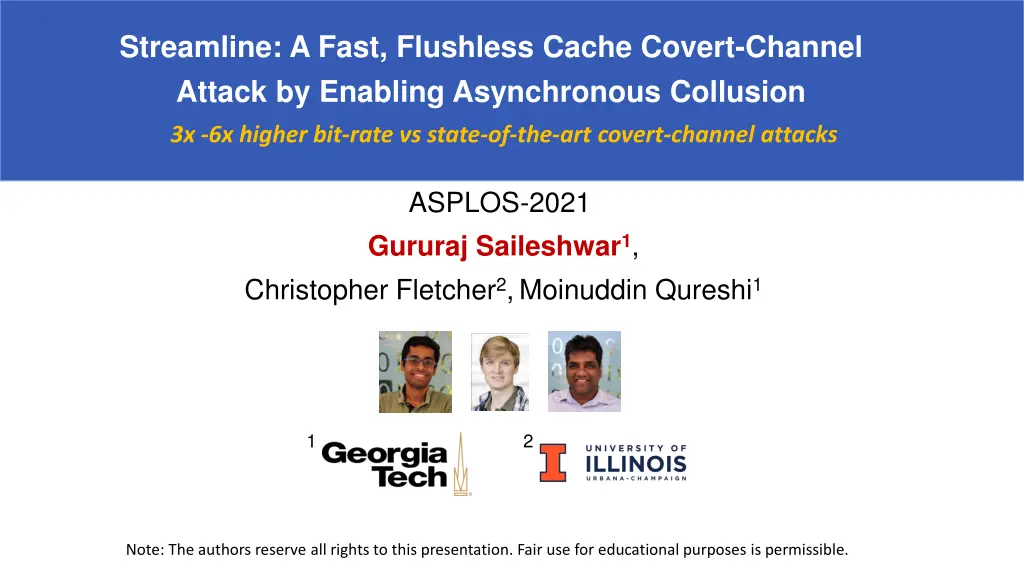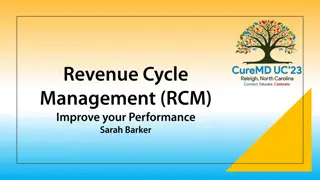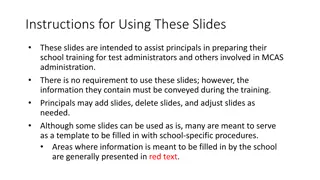
Enhancing Covert-Channel Attack Efficiency with Asynchronous Collusion
Discover how the Streamline attack improves Covert-Channel attack speed by 3x to 6x, introducing asynchronous collusion for faster and more efficient data transmission through cache covert channels. Learn about the challenges and contributions in making covert channels universally applicable across different ISAs.
Download Presentation

Please find below an Image/Link to download the presentation.
The content on the website is provided AS IS for your information and personal use only. It may not be sold, licensed, or shared on other websites without obtaining consent from the author. If you encounter any issues during the download, it is possible that the publisher has removed the file from their server.
You are allowed to download the files provided on this website for personal or commercial use, subject to the condition that they are used lawfully. All files are the property of their respective owners.
The content on the website is provided AS IS for your information and personal use only. It may not be sold, licensed, or shared on other websites without obtaining consent from the author.
E N D
Presentation Transcript
Streamline: A Fast, Flushless Cache Covert-Channel Attack by Enabling Asynchronous Collusion 3x -6x higher bit-rate vs state-of-the-art covert-channel attacks ASPLOS-2021 Gururaj Saileshwar1, Christopher Fletcher2,Moinuddin Qureshi1 1 2 Note: The authors reserve all rights to this presentation. Fair use for educational purposes is permissible.
What are Covert-Channels? Why Important? Sandbox Trojan Spy Last-Level Cache (LLC) Core-1 Core-0 Cache Covert-Channel [Perceival 05]: Trojan transmits bits covertly to Spy via Cache Contention Importance of Bit-rate: Determines Payload Size & Transmission Time
State-of-the-art Covert-Channels Flush+Reload Attack [USENIX-SEC 14] CORE-1 (Spy) CORE-0 (Trojan) LLC Limitations: 1 Flush 1. Synchronous Operation Bit-rate limited to < 500KB/s B Load 1 , No-Load 0 2 Reload: 3 2. Applicable to certain ISAs (x86) Requires unprivileged usage of Cacheline Flush Instruction (clflush) Hit/Miss 1 / 0 Wait & Repeat Wait & Repeat Shared Address (Read-only) Q. Real Upper Bound on Bit-rate for Cache Covert-Channels? Q. How to make these Universally Applicable to all ISAs?
Goal: Fast and Universal Covert-Channel Key Idea of Streamline Attack Make it Asynchronous and Flushless! Asynchronous FIFO-like Operation LLC Benefits S R Receiver Sender Fast: Bit-rate depends only on load execution-rate LLC-Hit 1 , LLC-Miss 0 Load 1 , No-Load 0 Cache-Thrashing Evicts Previous Lines Does not require explicit flushes: Applicable to all ISAs Shared Array Larger than LLC However, Asynchronous Channels Face Many Challenges For Low Error-Rates!
Challenges for Asynchronous Channels 2. Fooling Prefetcher 1. Rate-Matching Sender & Receiver LLC 3. Fooling Replacement-Policy LLC LLC R S S S Evicted by Replacement policy Prefetched Challenges for Streamline & All Future Asynchronous Channels
Contribution-1: Rate-Matching Sender & Receiver 1. Remove Payload-Dependent Rate-Variation with PRNG Channel-Encoding Bit Receiver Sender Rate-Matching LLC-Miss 1 LLC-Hit LLC-Miss 1 LLC-Hit Skipped 0 LLC-Miss Skipped 0 LLC-Miss Tx-i = Payload-i ^ PRNG-i; LLC Payload-i = Rx-i ^ PRNG-i; R 2. Match Sender & Receiver Operations Add timer instruction (rdtscp) to Sender & throttle its rate to match the Receiver S 3. Coarse-Grain Synchronization Every 200K bits (using any Covert-Channel) Sender-Receiver Gap (in bits) 102 103 104 105 Number of Bits Transmitted Number of Bits Transmitted Sender-Receiver Gap (in bits) Sender-Receiver Gap (in bits) 100000 100000 100000 PRNG Encoding PRNG Encoding PRNG Encoding PRNG-Modulation 80000 80000 80000 With Sender Rate-Throttling With Sender Rate-Throttling + Throttling Sender 60000 60000 60000 With Rate Throttling & Coarse-Synchronization + Coarse-Grain Sync Threshold for Bit Error Rate < 1% Error Rate < 1% Error Rate < 1% Threshold for Bit Threshold for Bit 40000 40000 40000 20000 20000 20000 0 0 0 104 104 105 105 107 107 107 102 102 103 103 Number of Bits Transmitted 106 106 106
Contributions-2,3: Fooling Prefetcher, Repl-Policy Fooling Prefetcher Fooling Replacement-Policy LLC S LLC 2x S 2x 2x 2x Repl-Policy Prefetcher Re-access LLC addresses to update reuse bits Stride of 3 across 2 pages
Results - Streamline Bit-Rate and Error-Rate Results on Intel Xeon E3-1270 (Skylake) (Also tested on i5/i7, Kaby-Lake/Coffee-Lake) Comparisons with Prior Attacks Attack Bit-Rate Error-Rate Streamline (LLC) 1800 KB/s 0.4% Flush-Flush (LLC)1 496 KB/s 0.8% Flush-Reload (LLC)1 298 KB/s <0.1% Bit-rate 1800 KB/s Take-a-Way (L1)2 588 KB/s 1 - 3% Not Prime-Probe (L1)3 400 KB/s Bit-error-rate 0.4% evaluated 1. [DIMVA 16], 2. [ASIACCS 20], 3. [BSDCan 05] Takeaways: 1. Fastest Cache Covert-Channel (3x vs FlushFlush, 6x vs FlushReload) 2. Flush-less applicable to all CPUs/ISAs.
Results Resilience to Noise Streamline error-rate under noise from co-running applications (Stress-NG Benchmarks) (averaged over 5 runs) 15% Sync-Period - 200,000 bits Sync-Period - 50,000 bits 0.8% At Smaller Synchronization Periods, Streamline uses smaller sized FIFOs in LLC to buffer bits and achieves Noise Resilience
Mitigation Strategy Restricting usage of flush instructions as a defense (SHARP-ISCA 17, ARM-ISA) does not prevent Streamline Noise injection as a defense provides limited protection, as Streamline can be made noise-resilient Detection based defenses (e.g. using Perf-Counters) also is limited in applicability: False positives and negatives Disabling Shared Memory or Partitioning Shared Caches (e.g. DAWG-MICRO 18) fully mitigates Streamline
Limitation: New Bottleneck in Covert Channels Measurement Bottleneck: Fundamentally Limits Bit-Rate of Streamline & Future Attacks Inability to Execute & Measure Latency of Multiple Loads in Parallel Using Counting-Thread [DIMVA 17] Using rdtscp [Intel SW Developer s Manual] Thread-0 load ctr load x load ctr -------- load ctr load y load ctr Thread-1 while(1){ ctr++; } rdtscp //read timer load x rdtscp//read timer Serialized due to Fence-like semantics of rdtscp -------- rdtscp//read timer load y rdtscp//read timer Serialized due to TSO ordering in Intel CPUs Overcoming this bottleneck and measuring load-latency of multiple loads in parallel, can unlock ~10x increase in bitrate of covert-channel
Conclusion Streamline Attack Streamline is flushless attack with broad applicability (all uarch, ISA) R S Covert-channel bit-rate 3x-6x higher than prior attacks Eliminates Synchronization Bottleneck in prior attacks Spy Trojan Measurement bottleneck limits all future attacks Addressing this can considerably increase bit-rates Sender Receiver Processor Cache






















